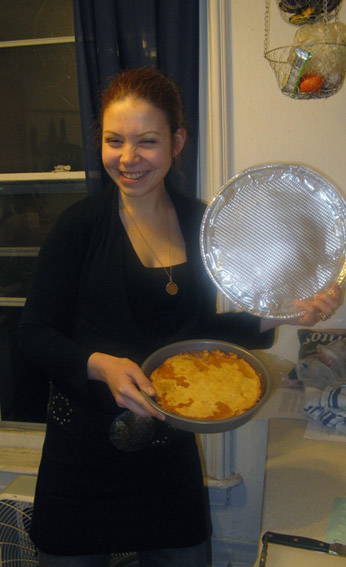Baklava is a fascinating dessert. Despite its simplicity, there are so many recipe versions for making it. And, despite its simplicity, it is actually possible to fail creating a tasty baklava. Just go into most ordinary shops: they’ll sell you a dry, flavorless imitation of baklava. A real shame.
Baklava – when successful – has a soft sweet taste with a crunchy background that will appeal to anyone. Even to those who are not particularly fond of sugarish desserts… such as my mother-in-law.
See, I just came back from a short “business” trip to France, where my husband and I stayed at my parents-in-law. And, this time, my mother-in-law had bought phyllo dough for me as I had promised her a while ago to teach her how to make baklava – a dessert I regularly make and which marked her after seeing a touching movie.
So let me resume the situation: I had to demonstrate baklava making to my mother-in-law (!) who dislikes desserts (!!), especially sugarish ones (!!!), and who was unaware of how sweet it had to be since she had never had baklava before (∞!).
To top that, while I had made it many times before, I had never actually written down my recipe with precise quantities. Therefore, although always good, the results varied. Of course, neither variation, nor “good results” are an option in such cases. I needed perfection.
That meant only one thing. I had to do a test run so I could make proper adjustments if needed. And so I did, just a day before flying off.
Baklava
Ingredients
(To comfortably fit into a 10x15inch or 12x17inch pan. Or even smaller if you prefer baklava with many layers.)
For the baklava:
1 package phyllo dough
2 sticks melted butter (1 cup)
1lb crushed/grinded walnuts (I personally like to have pieces of various size from small to very small)
1½tbsp cinnamon
3-4 oz sugar
For the sugar syrup:
1½ tsp vanilla extract
juice of 1 lemon + zest from about 1/3 of it
3 cups water
1½ cup + 2 tbsp sugar (to be used at once)
Directions
- Preheat the oven to 350°F.
- Mix the mixture ingredients together (walnuts, cinnamon, sugar). Now be prepared to work quickly with the phyllo dough so it doesn’t dry — exposure to air turns it quickly into flaky sheets, and it becomes a pain to work with.
- Brush the pan with melted butter; open the phyllo dough package, place two phyllo sheets, brush with butter , and then place one more (=total of 3 phyllo sheets for the bottom). Brush that last one too.
- Spread some of the baklava mixture evenly (make sure that even the borders get some mixture) — you should have enough for 4-5 layers. Place a phyllo sheet. Brush with butter. Repeat the procedure for a second one. (Total of 2 phyllo sheets between layers).
- Repeat step #4 until you reach your last layer of baklava mixture (4th or 5th). Then, instead of 2 phyllo sheets, use 3, buttering each.
- Bake for about 30 minutes. (Depending on your oven it can take anything between 25 and 35min. The best indication will be the golden color of the baklava. I could have left mine for a couple more minutes — it should have been slightly darker in color, but was in a hurry.)
- While your baklava is baking, or rather about 15 minutes into the baking process, start preparing the syrup. Place the sugar and water in sauce pan; bring to boil and then switch to simmering. Five minutes later, add lemon zest and half of the juice, as well as the vanilla. Wait a couple of minutes and taste the syrup. If the lemon juice isn’t overpowering the syrup, you should be able to add more. (I’ve discovered that some lemons have a much stronger taste influence than others which is why I don’t add it all at once. If you are feeling confident though, you can pour it all at once.) Keep the syrup on the stove for a total of 12 minutes. Finally remove the lemon zest using a strainer.
- As soon as your baklava is ready and out of the oven, pour the syrup over it.
- Let rest for 12 hours/overnight.
- Enjoy 😉
 Follow me
Follow me
10 Responses to Baklava